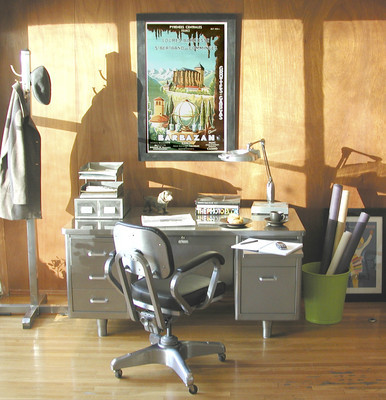STEELY LOOKS

When you see the furnishings offered by Twenty Gauge, there’s something comfortable and nostalgic about them. It could be the metal furnishings’ resemblance to that old high school locker or shelving that reminds you of the library in your home town.
And yet, there is something unfamiliar and modern about them, which could be from the rainbow of color accents or patterned glass desk tops.
It’s that dual aspect of the vintage steel furniture that appeals to company founder Jean-Christopher “J.C.” Hryb.
“I love its industrial look and the history, yet the lines are clean and they’re made of metal so it has that modern aspect,” he said.
Twenty Gauge specializes in restoring and revitalizing vintage furnishings from the 1930s through ’50s to give them new lives, albeit with a slightly modern twist.
“Some people think we are retro and some not at all. It just depends on who you ask,” said Karen Alweil, who co-founded the Los Angeles-based company 10 years ago.
The company’s line includes furnishings for the home office, living room, dining room and children’s spaces.
Alweil said the steel pieces blend well with a variety of decorating styles including modern, traditional and country.
“It can go from an eclectic look to a tailored look. It just depends on how the eye looks at it,” she said, adding that the steel furnishings themselves have a classic, timeless look.
Part of that look comes from current design trends. “Today’s design is very much ’50s inspired,” Hryb said.
Not only are Alweil and Hryb paying tribute to the past, they are concerned about the future and consider their company extremely green.
By refinishing the steel pieces, not only are they giving the furniture a new purpose, they are doing their part to recycle.
“There’s no extra waste on the environment. That’s important to us,” she said.
The two travel the world looking for pieces to transform.
Each piece is thoroughly restored and enhanced before it is sold.
“We add touches like wood and beautiful fabric to the upholstery,” Hryb said.
Before that, however, all corrosive elements are removed and any worn parts are replaced. Then each piece is sandblasted before it receives layers of powder coating to give it both color and strength.
“In the beginning, I made the two big mistakes most people make when they try restoration: sanding by hand and using paint and lacquer for color and protection,” Hryb said. “To be truly restored, a piece must have all the chemicals and rust removed from every part, seen or unseen, something that even tedious hand sanding can not do. Just a trace of rust will corrode through any new layer of paint and may not be apparent for a few years.”
Twenty Gauge began with a quest by Hryb for a desk that was both practical and interesting. He found a 1948 tanker desk at a flea market and set about restoring it. After stripping off several layers of paint, he discovered raw steel, which captivated his attention and motivated him to seek out other vintage steel pieces.
“J.C. in particular had always loved the look, and so did I,” Alweil said of why they decided to start the vintage furniture company.
Alweil, who also runs Karen Alweil Studio, a company that represents more than 30 artisans and manufacturers, was a sales representative for Hryb’s other company, Style de Vie, when their shared interest in vintage steel furniture surfaced.
Style de Vie specializes in vintage paper ephemera, which also is collected around the world before it is framed as art.
For more information, visit www.twentygauge.com.